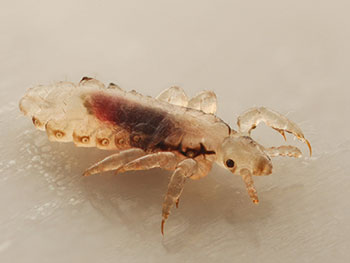Everything You Always Wanted to Know About Head Lice, But Were Afraid to Ask
by Dr. Elin Cohen, Lice Treatment Center® medical director and co-founder
Head lice are not dangerous or known to spread disease, but they certainly are a nuisance! The itching and discomfort can interfere with sleep or concentration, and a case of lice can cause unnecessary absence from work or school. Treatment is often laborious and time-consuming. The following information is meant to create an understanding about lice as a means of controlling the spread of lice and to aid in an approach to treatment.
According to the Centers for Disease Control, an estimated 6 million to 12 million cases of head lice occur each year in children ages 3 to 11 years. The numbers are significantly greater if one considers all the adults and teens affected as well. Lice are most commonly spread from head to head, and getting an infestation has nothing to do with someone’s personal hygiene practices.
The Louse Has Three Stages
Lice eggs, called "nits,” are very tiny, oval in shape, and get firmly glued to hair strands. They may be yellow or white in color, although they sometimes blend with a darker hair color. A nit takes eight or nine days to hatch, and viable nits are usually located within 1 centimeter (about 1/4 inch) of the scalp – most commonly at the nape of the neck or behind the ears. Nits can live for one week after leaving their host, but they require a temperature close to body temperature to hatch, so nits that aren’t on a person would be unviable.
Nymphs are immature lice that take nine to 12 days to mature. They cannot lay eggs in the immature phase, and they do not survive when away from a host.
 Adult lice are six-legged insects that are about the size of a sesame seed. The color is generally grayish-white, but lice can sometimes look darker. The mature females lay the eggs – generally from four to 10 eggs in a 24-hour period. Lice can move quickly, traveling at a rate of 6 to 30 centimeters per minute. They do not, however, hop or fly, so they can only spread by crawling from head to head. Mature lice can live for 30 days on a head, but if they are not on a human, they die within one to two days.
Adult lice are six-legged insects that are about the size of a sesame seed. The color is generally grayish-white, but lice can sometimes look darker. The mature females lay the eggs – generally from four to 10 eggs in a 24-hour period. Lice can move quickly, traveling at a rate of 6 to 30 centimeters per minute. They do not, however, hop or fly, so they can only spread by crawling from head to head. Mature lice can live for 30 days on a head, but if they are not on a human, they die within one to two days.
Lice Spread by Head To Head Contact
It is possible for a louse that has fallen off of a head onto a couch or carpet to crawl onto another person's head, but such a transfer is uncommon. On the other hand, lice can be spread easily through the sharing of brushes, combs, hair accessories, hats, helmets, scarves, or coats. Lice are not spread from household pets.
Many people feel overwhelmed when faced with a case of head lice on themselves or in the family. Successful treatment requires patience and often repetition, with a plan of killing any live bugs and avoiding any new ones! With a systematic approach, even the toughest cases can be beat.
Choose A Treatment Protocol With natural, non-toxic Essential Oils
There are several methods of eliminating the live lice and nymphs. Some people may choose from the commonly used pyrethrin- or permethrin-based shampoos and rinses. But I recommend choosing only treatment products formulated with natural, non-toxic essential oils as active ingredients.
After elimination of the live lice and nymphs, the next step is to perform a systematic “comb-out,” which involves dividing the hair into small, one-inch sections. Using a professional long-toothed lice comb, comb the sections from above, below, and from each side. This approach will almost always catch every nit and louse.
Occasionally, however, even after the most meticulous comb-out, people are devastated to find a cluster of nits the following day or within the week. Remember that it only takes one wily, fast moving louse to escape the treatment and lay its usual four to 10 nits every day.
However, if you continue for seven to 10 days with the systematic approach of applying all-natural, non-toxic treatment oils, shampoos and combings, every louse should be eliminated.
With a bit of patience and a calm approach, the system will work.
As for the house and environment, because lice and nits do not survive away from their human hosts, an environmental clean-up will effectively eliminate any risk of re-infestation. Bedding and washable items that have been in contact with the affected person within two days prior to treatment should be washed in hot water and dried in a high temperature cycle. Anything that isn’t washable can be sealed in a plastic bag for two weeks, which is more than enough time to isolate those items. Upholstery, floors, and carpets should be vacuumed. I don’t recommend using toxic sprays in living spaces.
Sources
Center for Disease Control. "Head Lice: Fact Sheet" (Online) 10 September, 2008. <http.//www.cdc.gov/lice/head/factsheet.html>
Frankowski et al. "American Academy of Pediatrics-Clinical Report on Head Lice." Pediatrics, 110 no. 3 (2002): 638-643.
Up To Date. "Pediculosis" (Online) 23 October 2007. <https.//netaccess.svhs-ct.org/utd>
Dr. Elin Cohen, a pediatrician and mother of two, is the medical director of the Lice Treatment Center (LTC). She has formulated the non-toxic, natural by LTC line of lice treatment and prevention products for LTC. LTC products are available online at www.licetreatmentcenter.com and in select stores.
